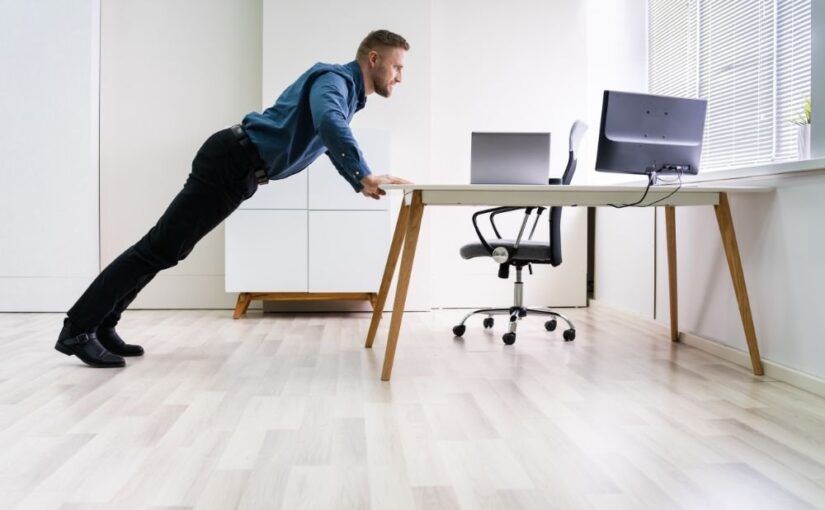In the modern workplace, it’s common for people to spend extended periods seated at their desks. This sedentary lifestyle can lead to various health issues, including poor posture, back pain, and decreased energy levels. However, incorporating simple desk exercises into your workday can help counteract these effects, boost productivity, and improve overall well-being. Here are some effective desk exercises, along with their benefits and recommended frequency.
1. Seated Leg Raises
This simple exercise helps strengthen your legs and improve circulation.
How to do it:
- Sit up straight in your chair.
- Extend one leg straight out in front of you, holding it for a few seconds.
- Lower it back down without letting your foot touch the floor.
- Benefits: Strengthens leg muscles and promotes blood flow.
- Frequency: Aim for 10-15 repetitions on each leg, a few times a day.
2. Desk Push-Ups
A great way to strengthen your upper body, desk push-ups can be done using your desk as support.
How to do it:
- Stand a few feet away from your desk.
- Place your hands on the desk’s edge, shoulder-width apart.
- Lower your chest towards the desk while keeping your body straight.
- Push back to the starting position.
- Benefits: Strengthens arms, chest, and core muscles.
- Frequency: Aim for 10-15 repetitions, 2-3 times during your workday.
3. Neck Stretches
Sitting at a desk can lead to tension in your neck. Regular stretches can alleviate this discomfort.
How to do it:
- Sit up straight and drop your right ear towards your right shoulder.
- Sustain for about 15-30 seconds, feeling the stretch on the left side of your neck.
- Switch sides and repeat.
- Benefits: Reduces neck stiffness and improves flexibility.
- Frequency: Perform 2-3 times on each side, ideally every hour.
4. Shoulder Rolls
Shoulder rolls are a great way to relieve stress and improve posture.
How to do it:
- Either stand or sit with your arms relaxed by your sides.
- Roll your shoulders forward in a circular motion, 10 times.
- Then, roll them backward for another 10 repetitions.
- Benefits: Relieves shoulder tension and promotes better posture.
- Frequency: Do this every hour or whenever you feel tension building.
5. Seated Torso Twist
This exercise helps stretch your spine and improve flexibility.
How to do it:
- Sit up straight in your chair.
- Twist your torso to the right while looking over your shoulder and placing your right hand on the back of your chair.
- Hold for 15-30 seconds, then switch sides.
- Benefits: Improves spinal mobility and alleviates lower back tension.
- Frequency: Repeat 2-3 times on each side, ideally every couple of hours.
6. Standing Calf Raises
Stand up for a quick workout that targets your calf muscles.
How to do it:
- Stand up behind your chair, holding onto the back for support.
- Using your toes to balance, raise your heels off the ground.
- Lower back down slowly.
- Benefits: Strengthens calf muscles and improves circulation.
- Frequency: Aim for 10-15 repetitions, 2-3 times a day.
7. Wrist and Finger Stretches
Long periods of typing can lead to stiffness in your hands and wrists.
How to do it:
- Put one arm out in front of you, palm facing up.
- Use the opposite hand to gently pull back on your fingers.
- Hold for 15-30 seconds, then switch hands.
- Benefits: Reduces stiffness and prevents repetitive strain injuries.
- Frequency: Perform this stretch 2-3 times on each side, especially after long typing sessions.
8. Mini Workouts
Consider incorporating short bursts of exercise during breaks. Set a timer for every hour to remind you to get up and move.
Examples include:
- Quick walks around your office.
- Climbing stairs if available.
- Doing jumping jacks or high knees for a minute.
- Benefits: Boosts energy levels, enhances mood, and improves overall productivity.
- Frequency: Take a 5-minute movement break every hour.
Desk Exercises Quick Guide
| Exercise | Target Area | Key Benefits | Frequency |
|---|
| Seated Leg Raises | Legs, Circulation | Strengthens legs, improves blood flow | 10–15 reps per leg, 2–3x/day |
| Desk Push-Ups | Arms, Chest, Core | Builds upper body strength | 10–15 reps, 2–3x/day |
| Neck Stretches | Neck | Reduces stiffness, improves flexibility | Every hour |
| Shoulder Rolls | Shoulders, Upper Back | Eases tension, improves posture | Every hour |
| Seated Torso Twist | Spine, Lower Back | Enhances mobility, relieves back tension | 2–3x per side, 2x/day |
| Standing Calf Raises | Calves | Boosts circulation, strengthens calves | 10–15 reps, 2–3x/day |
| Wrist/Finger Stretches | Hands, Wrists | Prevents strain, improves flexibility | After typing sessions |
| Mini Workouts | Full Body | Boosts energy, breaks up sedentary time | 5 min every hour |
Conclusion
Incorporating desk exercises into your daily routine is a simple yet effective way to combat the negative effects of prolonged sitting. These exercises can help improve circulation, reduce muscle tension, and increase your overall energy levels. Aim to integrate these movements into your workday regularly, listening to your body and adjusting as needed. Staying active, even at your desk, can lead to a healthier and more productive workday!
Frequently Asked Questions (FAQ)
Desk exercises help counteract the negative effects of prolonged sitting, such as poor posture, muscle stiffness, and reduced circulation.
Aim for short exercises every hour. Even 5–10 minutes of movement can improve energy, focus, and physical comfort.
No, most desk exercises use only your body weight and can be done using your chair or desk as support.
Yes. Movements like shoulder rolls, neck stretches, and torso twists help relieve tension and reinforce good posture habits.
Absolutely. Light movement throughout the day increases endorphins, reduces muscle tension, and helps clear mental fatigue.
Helpful Gear to Support Desk Exercises
If you’re looking to enhance your workstation and support a more active work routine, here are a few helpful accessories that can complement your desk exercises:
Standing Desks
Adjustable standing desks allow you to alternate between sitting and standing throughout the day, promoting better posture and reducing sedentary time.
Balance Ball Chairs
These ergonomic alternatives to traditional chairs engage your core muscles and encourage better spinal alignment while you work.
Under-Desk Ellipticals
Compact and easy to use, under-desk ellipticals let you keep your legs moving and circulation flowing while staying focused on work.
Affiliate Disclaimer
The links above are affiliate links, which means we may earn a small commission if you make a purchase through them, at no additional cost to you.

